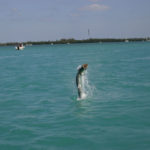The top 5 mistakes anglers make when fishing streams
Ever wonder why you see more fish tail darting away from you than on the end of your line? These are some of the most common mistakes I have witnessed in my many hours spent on and in streams. They are especially relevant now, as many anglers prepare for spring fishing.
1. They are too obvious
Many times I have watched and listened in amazement as an angler came crashing out of the weeds, thundering down the bank and right up to the water’s edge in the middle of a bright, clear day. There is no surer way to put the fish down for an extended period of time than to scare them into hiding. A loud and obvious approach resembling that of a brown bear in search of fresh fish is a good way to accomplish that. Try to blend in with your surroundings. Savvy anglers approach the water with stealth, crouching over and even crawling when necessary.
2. Their clothes are too bright
This is tied in with number 1. Fish have eyes. And those eyes can be used to see out of the water. Think about it. Fish in streams are much more exposed than their counterparts in deep lakes. They need to be wary. Fish like trout, char and salmon have developed the ability to sense danger from above. Wear drab, flat colors whenever you can. Avoid bright hats especially, as they are on the highest part of your body and thus most obvious to fish. Save the blaze orange for hunting season.
3. Their gear is too heavy
Many times I’ve watched anglers hurl massive balls of Powerbait attached to huge hooks on heavy line at small hatchery trout. But this doesn’t just apply to small fish. Many anglers go way overboard when rigging for much larger fish like steelhead and even salmon. Eight pound test line is hardly needed when fishing for trout that weigh less than a pound. Six pound test isn’t needed in streams that hold no fish over a pound and a half. If you set your drag properly and play the fish as you should, you can get away with line rated much lower than the size of the fish you’re after. The same goes for hooks. When used correctly, small hooks can hold big fish. Ten pound steelhead can be and are caught on size 14 hooks tied to 2 and 4 pound test line. The same goes for other species. Don’t forget that larger line, big sinkers and float and large hooks are more visible to fish. Unless the situation absolutely calls for heavy equipment, scale down. You’ll catch more fish.
4. They wade too much
I can’t count how many times I’ve watched anglers wade out in water over their knees in a stream that they could cast across with ease. Waders are useful tools. They enable us to get to fish we otherwise may not be able to reach. But just because you’re protected from water up to your chest doesn’t mean you have to prove it. Every splash and movement you make in the water increases your chances of being detected. And spooked fish aren’t nearly as likely as calm fish to bite… or even hang around. Wade only as much as is absolutely necessary.
5. They aren’t mobile
Anglers often fish the same hole for hours, with no results. In most cases, if you have tried a variety of approaches and haven’t caught anything, it’s time to move on. Mobility often leads to increased success. The more fish you put your bait in front of, the better your odds. Additionally, large fish are more often found outside of popular fishing holes than in them. Don’t be afraid to explore! Just be careful in your approach (see numbers 1-4).
About
http://www.anglersnotebook.com contains tips, tricks, strategies and tactics accumulated over decades of fishing experience. The author has fished throughout the United States and around the world, participated in tournaments and contests, worked in and around fishing product manufacturers, guides and retailers, won numerous awards, and appeared in numerous publications.











Leave a Reply